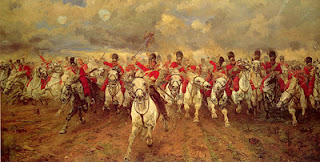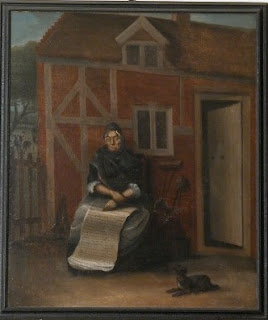 Today is the anniversary of the day when Dartmoor Prison opened its doors (so to speak) to French prisoners of war in 1809. The prison was constructed 1806-1809 to contain the overflow of French prisoners from the hulks, notorious for their high mortality rates and wretched living conditions. Dartmoor may not have been much better, considering that over 1,500 men died there, including prisoners from the War of 1812. This is the cemetery which has been restored by volunteers.
Today is the anniversary of the day when Dartmoor Prison opened its doors (so to speak) to French prisoners of war in 1809. The prison was constructed 1806-1809 to contain the overflow of French prisoners from the hulks, notorious for their high mortality rates and wretched living conditions. Dartmoor may not have been much better, considering that over 1,500 men died there, including prisoners from the War of 1812. This is the cemetery which has been restored by volunteers.
I poked around on the web a bit and came up with some fascinating stuff about Dartmoor–the stuff of fiction (and I’m sure it’s been done). For instance, officers were allowed parole and became involved with the local community, some marriages taking place, according to the Moretonhampstead Historical Society. (Confusingly but understandably Moretonhampstead is also known as Moreton.)
The POWs were eager to pitch in during a crisis, as in 1808 when the Dolphin Inn caught fire and put other buildings in danger:
About noon a fire broke out at the Dolphin public house, kept by Mr Wm. Tozer, which raged with alarming violence over several houses, threatening the destruction of a great part of the town… its progress was happily stopped, by the energetic exertions of the inhabitants, the Moreton volunteers…
It was pleasing to see about 1,500 people of different languages and colours uniting with great cheerfulness in making breaches to stop the progress of the flames, in removing furniture and goods to places of security, and in carrying water to supply a powerful engine, which was kept constantly at work at different points for several hours.
And in the evening, the thanks of a meeting of gentlemen at the White Hart was ordered to be communicated through Captn Ponsford to the volunteers and the foreigners who assisted. More
Different languages and colours–that’s significant. We know there were black POWs–the above source mentions that in the previous year, “General Rochambeau, a French Officer with a black servant, came here on parole from Wincanton, Somerset.” It suggests that more than just officers were enjoying the pleasures of parole–maybe regular soldiers hired themselves out as servants to get out for a while?–and who pitched in so enthusiastically to put out the fire.
The General’s servant certainly had the opportunity to socialize:
Married with licence Peter the Black, servant to General Rochambeau, to Susanna Parker. The bells rang merrily all day. From the novelty of this wedding being the first negro ever married in Moreton, a great number assembled in the churchyard, and paraded down the street with them.
 But there weren’t so many happy endings connected with Dartmoor. More, it was a history of misery, culminating in the massacre of April 6, 1815. We don’t really know what happened. Certainly the prisoners, living in harsh conditions, and well after the end of the War of 1812, were enraged that they were still in captivity. The warden, Captain Shortland, exhibited terrible judgment; he may have believed an escape was planned, but almost certainly the dispute started when he prevented distribution of bread to the prisoners, and ended with his orders to fire on them. Seven died, including a boy of fourteen. Between thirty and sixty were wounded. A joint British-American panel later investigated the tragedy and paid reparation to the families of the dead men.
But there weren’t so many happy endings connected with Dartmoor. More, it was a history of misery, culminating in the massacre of April 6, 1815. We don’t really know what happened. Certainly the prisoners, living in harsh conditions, and well after the end of the War of 1812, were enraged that they were still in captivity. The warden, Captain Shortland, exhibited terrible judgment; he may have believed an escape was planned, but almost certainly the dispute started when he prevented distribution of bread to the prisoners, and ended with his orders to fire on them. Seven died, including a boy of fourteen. Between thirty and sixty were wounded. A joint British-American panel later investigated the tragedy and paid reparation to the families of the dead men.
Captain Shortland went at the head of the soldiers and ordered all of the prisoners back. They refused and, as the bread wagon was at this moment making a delivery to the stores, there was a fear that the prisoners might attempt to take control. Again the order was given to return while the soldiers fixed bayonets and began to advance. They were about three paces from the prisoners but still the Americans stood firm and refused to back down. The order to charge was given and the prisoners instantly broke and ran as fast as possible to the safety of their prisons. There were thousands of Americans desperately trying to get back into the buildings but they could not do so quickly. The order to fire was given, there is some doubt as to who by, but the Americans later insisted that it was Captain Shortland. The soldiers obeyed and fired a full volley. The volleys were repeated for several rounds with prisoners falling dead and wounded all around. The Complete Illustrated History of Dartmoor Prison by Ron Joy. Quoted by Illinois War of 1812 Society.
On the topic of escape–you have to remember that one of the (unofficial) trades of Devon was smuggling, and who better than to help, for a price, prisoners escape. Records exist of the more unsuccessful attempts.
 More sources. They’re scattered, but some records exist at the UK National Archives and you can find a bibliography from the Moretonhampstead Historical Society. First-hand accounts exist at the Navy Department Library in Washington, DC, including this one with its frontispiece of the prison:
More sources. They’re scattered, but some records exist at the UK National Archives and you can find a bibliography from the Moretonhampstead Historical Society. First-hand accounts exist at the Navy Department Library in Washington, DC, including this one with its frontispiece of the prison:
Journal, of a Young Man of Massachusetts, Late a Surgeon on Board an American Privateer, Who Was Captured at Sea by the British . . . and Was Confined First, at Melville Island, Halifax, Then at Chatham, in England, and Last, at Dartmoor Prison. Interspersed with Observations, Anecdotes and Remarks, Tending to Illustrate the Moral and Political Characters of Three Nations. To Which Is Added, a Correct Engraving of Dartmoor Prison, Representing the Massacre of American Prisoners. Written by Himself. Boston: printed by Rowe & Hooper, 1816.
I find this history of Dartmoor both sad and fascinating. Do you have any recommendations for books, fiction or nonfiction, about Dartmoor and its prisoners?
And oh gosh, a late addition, The Malorie Phoenix for Kindle is now on sale for 99 cents. Go grab it and please please write me a review (if you like it).












